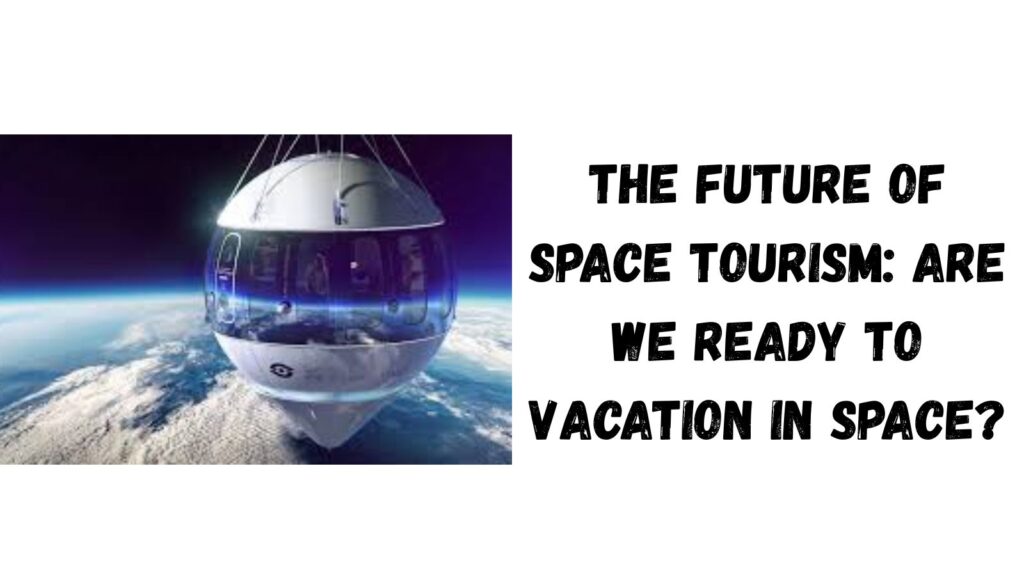Space tourism has long been a dream of science fiction, but in recent years, it has moved closer to becoming a reality. Imagine booking a space vacation. You could see Earth from orbit and feel weightless. This once seemed impossible. Space tourism has moved from theory to real projects. Some of the most innovative companies in the world are now developing it. Thanks to new technology, more investments, and private space missions, vacationing in space may be closer than we imagined.
In this article, we’ll explore space tourism. We’ll look at recent developments and how near we are to making it available to everyone. Also, we’ll imagine what a space vacation might be like in the future. Let’s explore this fascinating frontier and answer the burning question: Are we ready to vacation in space?

The Dawn of Space Tourism: A Quick History
Contents
- 1 The Dawn of Space Tourism: A Quick History
- 2 Exciting Developments in Space Tourism
- 3 What Will Space Tourism Be Like in the Coming Decades?
- 4 Conclusion: Are We Ready for Space Vacations?
- 5 FAQs
- 6 What is space tourism?
- 7 Who can go on space tourism trips?
- 8 How much does a space tourism ticket cost?
- 9 When will space tourism become affordable for everyone?
- 10 Will space tourism be safe?
The idea of space tourism has been around since the early days of space exploration. However, it wasn’t until the late 1990s and early 2000s that space tourism started to gain momentum.
1. The First Space Tourist In 2001, Dennis Tito, an American businessman, became the first space tourist. He paid a whopping $20 million to travel to the International Space Station (ISS) aboard a Russian Soyuz spacecraft. This was a big moment for space tourism. It showed that civilians can go to space, even if it costs a lot.
2. The Rise of Private Space Companies As NASA and other agencies explored space, private companies began to enter the field.
In the early 2000s, Richard Branson’s Virgin Galactic, Jeff Bezos’s Blue Origin, and Elon Musk’s SpaceX emerged as key players. They aimed to make space accessible to private citizens.
- Virgin Galactic: Started in 2004, Virgin Galactic began creating suborbital flights for commercial passengers. Their goal was to make space tourism an affordable and accessible experience for the masses.
- Blue Origin: In 2000, Jeff Bezos founded Blue Origin with the mission to reduce the cost of space travel and make it accessible to more people. Their New Shepard rocket is designed to take tourists to the edge of space for a few minutes of weightlessness.
- SpaceX: It started with a goal to transport people to the International Space Station. But soon, SpaceX set its sights on bigger dreams, like private space tourism. Their Crew Dragon spacecraft and Starship rocket aim to take humans beyond Earth. They could go to the Moon and even Mars.
These companies and others are pushing the space tourism industry ahead. Every year, they announce new advancements and missions.
Exciting Developments in Space Tourism
1. Suborbital Flights: The First Step Toward Space Tourism
Suborbital flights are the first step for many tourists who want to experience space. Suborbital spaceflights are quick. Passengers spend just a few minutes in space. These flights take off and land on Earth within a short span of time, typically about 10 to 15 minutes.
- Virgin Galactic: SpaceShipTwo is a reusable spacecraft. It has completed several successful test flights. The company will provide suborbital flights to the edge of space. Passengers can enjoy a few minutes of weightlessness and see Earth from above.
- Real-Time Example: In July 2021, Richard Branson, founder of Virgin Galactic, flew to space. He was one of the first to ride the company’s SpaceShipTwo. This marked a new era for commercial space travel.
- Blue Origin: In 2021, Blue Origin launched its New Shepard rocket. Jeff Bezos and other passengers took a brief trip to space. Blue Origin aims to make space tourism a sustainable and repeatable experience. They focus on keeping environmental impact low.
Fun Fact: Blue Origin’s New Shepard rocket is named after Alan Shepard, the first American astronaut to travel into space in 1961. It was fitting that Jeff Bezos and his crew were aboard this rocket as part of the modern era of space tourism.
2. Orbital Space Tourism: A Step Further
While suborbital flights offer a glimpse of space, orbital space tourism is a whole new level of experience. These flights take passengers to Earth’s orbit. They can stay in space longer and see the Earth from a new view.
- SpaceX: SpaceX is taking space tourism to new heights with its Crew Dragon spacecraft. In 2021, SpaceX launched the Inspiration4 mission, which sent four private citizens into space for three days. Real-Time Example: The Inspiration4 mission raised $200 million for St. Jude Children’s Research Hospital. This shows how space tourism can be a strong tool for charity.
- Axiom Space plans to send civilians on missions to the International Space Station soon. Axiom’s mission will allow space tourists to stay on the ISS, conducting experiments and exploring space firsthand. The company has already signed contracts with several space tourists who are eager to book their tickets.
3. Space Hotels and Extended Stays
As technology advances, space tourism is expected to evolve into extended stays in space. A new era of space hotels may be on the horizon. Tourists could enjoy long stays in zero gravity. They might take part in spacewalks and explore the vastness of space, not just through short suborbital flights.
- The Orbital Assembly Corporation is building the Voyager Station. This luxury space hotel will host up to 400 guests. Voyager Station offers artificial gravity, a rotating design, and stunning views of Earth. It aims to be the first real luxury space vacation spot.
- Blue Origin’s Orbital Reef: Blue Origin, with Sierra Nevada Corporation and Boeing, is creating Orbital Reef. This commercial space station will be a hub for tourists and astronauts. Orbital Reef is set to launch in the mid-2020s. It will enable longer stays in space and include labs, crewed habitats, and more.
What Will Space Tourism Be Like in the Coming Decades?
The future of space tourism is incredibly exciting, with the potential to transform the way we think about travel. In the next few decades, space tourism could become far more affordable, accessible, and diverse. Here are some key trends to look forward to:
1. Affordable Space Travel
As technology advances, the cost of space tourism will likely decrease. Right now, space tourism is very costly. Tickets can cost hundreds of thousands or even millions of dollars. As companies grow, reuse rockets, and cut costs, space tourism prices will fall. Eventually, space tourism could become as accessible as commercial air travel.
2. Space Tourism for the Masses
In the coming decades, space tourism will no longer be a niche luxury. The goal is to open up the experience to a broader range of people.
3. Space Colonization
Space tourism now mainly offers short trips to orbit or suborbital flights. In the future, it might include living on other planets. Companies like SpaceX have ambitions to colonize Mars, and if successful, this could open up a new frontier for space tourism. Imagine taking a vacation to Mars, staying in a Martian colony, and experiencing life on another planet.
Conclusion: Are We Ready for Space Vacations?
Space tourism is no longer a concept limited to science fiction. Thanks to new technology, more investment, and successful missions, space tourism is now easier and more possible. In the coming decades, more people may vacation in space. This will open new frontiers for travel and exploration.
Space tourism has a bright future. However, many challenges remain. We need to lower the cost of travel, keep passengers safe, and create better facilities for longer stays in space. We may be on the brink of a new era of travel, where the ultimate destination is the vastness of space itself.
Why Vegetable Insurance Is Essential for Farmers in 2025: Protecting Your Crops from Uncertainty
FAQs
What is space tourism?
Space tourism is commercial travel in space for fun, leisure, or adventure. It involves journeys beyond Earth’s atmosphere, allowing civilians to experience space firsthand.
Who can go on space tourism trips?
Right now, space tourism is for those who can pay the high ticket prices. These usually range from hundreds of thousands to millions of dollars. However, in the future, prices are expected to decrease, making space tourism more accessible to the general public.
How much does a space tourism ticket cost?
Space tourism ticket prices vary. Suborbital flights from Virgin Galactic and Blue Origin usually cost between $200,000 and $500,000 per seat. Orbital flights and longer missions can cost several million dollars.
When will space tourism become affordable for everyone?
Experts say space tourism may become affordable in the future. As technology improves and production scales up, prices are likely to drop. This could happen over the next few decades.
Will space tourism be safe?
Safety is a top priority for companies involved in space tourism. Testing, astronaut training, and advanced technology help keep passengers safe. However, as with any new industry, there are inherent risks that need to be carefully managed.


